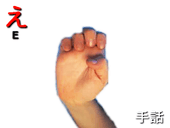E (kana)
In Japanese writing, the kana え (hiragana) and エ (katakana) (romanised e) occupy the fourth place, between う and お, in the modern Gojūon (五十音) system of collating kana. In the Iroha, they occupy the 34th, between こ and て. In the table at right (ordered by columns, from right to left), え lies in the first column (あ行, "column A") and the fourth row (え段, "row E"). Both represent [e].
| Form | Rōmaji | Hiragana | Katakana |
|---|---|---|---|
| Normal a/i/u/e/o (あ行 a-gyō) |
e | え | エ |
| ei ee ē |
えい, えぃ ええ, えぇ えー |
エイ, エィ エエ, エェ エー |
| e | ||||
|---|---|---|---|---|
| ||||
| transliteration | e | |||
| hiragana origin | 衣 | |||
| katakana origin | 江 | |||
| spelling kana | 英語のエ (Eigo no "e") | |||
| kana gojūon | ||||||||||||||||||||||||||||||||||||||||||||||||||
|---|---|---|---|---|---|---|---|---|---|---|---|---|---|---|---|---|---|---|---|---|---|---|---|---|---|---|---|---|---|---|---|---|---|---|---|---|---|---|---|---|---|---|---|---|---|---|---|---|---|---|
|
||||||||||||||||||||||||||||||||||||||||||||||||||
Derivation
え and エ originate, via man'yōgana, from the kanji 衣 and 江, respectively.
The archaic kana ゑ (we), as well as many non-initial occurrences of the character へ (he), have entered the modern Japanese language as え. The directional particle へ is today pronounced "e", though not written as え. Compare this to は (ha) and を (wo), which are pronounced "wa" and "o" when used as grammatical particles.
For the kana romanized sometimes as "e", see we (kana).
Variant forms
Scaled-down versions of the kana (ぇ, ェ) are used to express morae foreign to the Japanese language, such as ヴェ (ve). In several Okinawan writing systems, a small ぇ is also combined with the kana く(ku) and ふ (fu or hu) to form the digraphs くぇ kwe and ふぇ hwe.
Transliteration
In the Hepburn, Kunrei-shiki and Nihon-shiki systems of romanization, both え and エ are transliterated as "e". In the Polivanov system of cyrillization, the kana are transliterated as "э".
Stroke order
 Stroke order in writing え |
 Stroke order in writing エ |

The hiragana え is made with two strokes:
- At the top, a short diagonal stroke proceeding downward and to the right.
- At the bottom, a stroke composed of a horizontal line, a diagonal proceeding downward and to the left, and a rightward stroke resembling a tilde (~).

The katakana エ is made with three strokes:
- At the top, a horizontal stroke from left to right.
- A downward vertical stroke starting in the center of the first stroke.
- At the bottom, a horizontal stroke parallel to the first stroke, and touching the second. This stroke is usually slightly longer than the first.
This is also the way to make the Latin letter "I" (although the correct upper case form does not look like the lower case Latin letter "l")
Other communicative representations
| Japanese radiotelephony alphabet | Wabun code |
| 英語のエ Eigo no "E" |
▄▄▄▄▄▄▄▄▄▄▄▄▄▄▄▄▄▄▄▄ |
|
|
 |
 | |
| Japanese Navy Signal Flag | Japanese semaphore | Japanese manual syllabary (fingerspelling) | Braille dots-124 Japanese Braille |
- Full Braille representation
| え / エ in Japanese Braille | |
|---|---|
| え / エ e | えい / エー ē/ei |
| Preview | え | エ | エ | |||
|---|---|---|---|---|---|---|
| Unicode name | HIRAGANA LETTER E | KATAKANA LETTER E | HALFWIDTH KATAKANA LETTER E | |||
| Encodings | decimal | hex | decimal | hex | decimal | hex |
| Unicode | 12360 | U+3048 | 12456 | U+30A8 | 65396 | U+FF74 |
| UTF-8 | 227 129 136 | E3 81 88 | 227 130 168 | E3 82 A8 | 239 189 180 | EF BD B4 |
| Numeric character reference | え | え | エ | エ | エ | エ |
| Shift JIS[1] | 130 166 | 82 A6 | 131 71 | 83 47 | 180 | B4 |
| EUC-JP[2] | 164 168 | A4 A8 | 165 168 | A5 A8 | 142 180 | 8E B4 |
| GB 18030[3] | 164 168 | A4 A8 | 165 168 | A5 A8 | 132 49 151 54 | 84 31 97 36 |
| EUC-KR[4] / UHC[5] | 170 168 | AA A8 | 171 168 | AB A8 | ||
| Big5 (non-ETEN kana)[6] | 198 172 | C6 AC | 199 64 | C7 40 | ||
| Big5 (ETEN / HKSCS)[7] | 198 238 | C6 EE | 199 164 | C7 A4 | ||
| Preview | ぇ | ェ | ェ | |||
|---|---|---|---|---|---|---|
| Unicode name | HIRAGANA LETTER SMALL E | KATAKANA LETTER SMALL E | HALFWIDTH KATAKANA LETTER SMALL E | |||
| Encodings | decimal | hex | decimal | hex | decimal | hex |
| Unicode | 12359 | U+3047 | 12455 | U+30A7 | 65386 | U+FF6A |
| UTF-8 | 227 129 135 | E3 81 87 | 227 130 167 | E3 82 A7 | 239 189 170 | EF BD AA |
| Numeric character reference | ぇ | ぇ | ェ | ェ | ェ | ェ |
| Shift JIS[1] | 130 165 | 82 A5 | 131 70 | 83 46 | 170 | AA |
| EUC-JP[2] | 164 167 | A4 A7 | 165 167 | A5 A7 | 142 170 | 8E AA |
| GB 18030[3] | 164 167 | A4 A7 | 165 167 | A5 A7 | 132 49 150 54 | 84 31 96 36 |
| EUC-KR[4] / UHC[5] | 170 167 | AA A7 | 171 167 | AB A7 | ||
| Big5 (non-ETEN kana)[6] | 198 171 | C6 AB | 198 254 | C6 FE | ||
| Big5 (ETEN / HKSCS)[7] | 198 237 | C6 ED | 199 163 | C7 A3 | ||
- Archaic and Hentaigana
| Preview | 𛀀 | 𛀁 | ||
|---|---|---|---|---|
| Unicode name | KATAKANA LETTER ARCHAIC E | HIRAGANA LETTER ARCHAIC YE | ||
| Encodings | decimal | hex | decimal | hex |
| Unicode | 110592 | U+1B000 | 110593 | U+1B001 |
| UTF-8 | 240 155 128 128 | F0 9B 80 80 | 240 155 128 129 | F0 9B 80 81 |
| UTF-16 | 55340 56320 | D82C DC00 | 55340 56321 | D82C DC01 |
| Numeric character reference | 𛀀 | 𛀀 | 𛀁 | 𛀁 |
References
- Unicode Consortium (2015-12-02) [1994-03-08]. "Shift-JIS to Unicode".
- Unicode Consortium; IBM. "EUC-JP-2007". International Components for Unicode.
- Standardization Administration of China (SAC) (2005-11-18). GB 18030-2005: Information Technology—Chinese coded character set.
- Unicode Consortium; IBM. "IBM-970". International Components for Unicode.
- Steele, Shawn (2000). "cp949 to Unicode table". Microsoft / Unicode Consortium.
- Unicode Consortium (2015-12-02) [1994-02-11]. "BIG5 to Unicode table (complete)".
- van Kesteren, Anne. "big5". Encoding Standard. WHATWG.
| Look up え, ぇ, エ, or ェ in Wiktionary, the free dictionary. |

